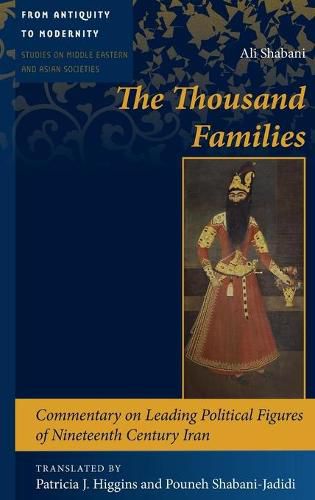Readings Newsletter
Become a Readings Member to make your shopping experience even easier.
Sign in or sign up for free!
You’re not far away from qualifying for FREE standard shipping within Australia
You’ve qualified for FREE standard shipping within Australia
The cart is loading…






This title is printed to order. This book may have been self-published. If so, we cannot guarantee the quality of the content. In the main most books will have gone through the editing process however some may not. We therefore suggest that you be aware of this before ordering this book. If in doubt check either the author or publisher’s details as we are unable to accept any returns unless they are faulty. Please contact us if you have any questions.
The Thousand Families by Ali Shabani, former court journalist and writer under Mohammad Reza Shah, is a lively and entertaining anecdotal history of the Qajar family, who ruled Iran from 1796 to 1925, as well as a number of their associates. Using memoirs, diaries, government documents, and nineteenth century histories, the author paints a vivid picture of the strengths and weaknesses, character and habits, and family backgrounds and familial legacies of the leading figures of the day. He comments, often ironically and with novel metaphors and sometimes biting criticism, on the behavior of these leaders, and he provides concise observations concerning the effects of their actions on the country and people of Iran. He outlines as well the policies and practices of the Qajars with respect to governance and traces the changes effected in the overall governmental structure of Iran during the nineteenth and early twentieth century. The gradually increasing influence of foreign powers (primarily Great Britain and Russia) throughout this era does not escape the author’s acerbic comments. Appendices provide extensive documentation on kinship relationships within the royal family.
The translators have added notes, bracketed in the text and in footnotes, to help orient readers less familiar with Iranian history than the author’s original audience. These include key dates, more detail on sources (when available), reference to easily accessible additional information on key figures, and explanations of selected Persian sayings, customs, and practices.
Scholars and students of Iran, the Middle East, and the nineteenth century in general will find this book of interest, as will the general reader interested in royalty, political systems, revolution, and center-periphery relationships.
$9.00 standard shipping within Australia
FREE standard shipping within Australia for orders over $100.00
Express & International shipping calculated at checkout
This title is printed to order. This book may have been self-published. If so, we cannot guarantee the quality of the content. In the main most books will have gone through the editing process however some may not. We therefore suggest that you be aware of this before ordering this book. If in doubt check either the author or publisher’s details as we are unable to accept any returns unless they are faulty. Please contact us if you have any questions.
The Thousand Families by Ali Shabani, former court journalist and writer under Mohammad Reza Shah, is a lively and entertaining anecdotal history of the Qajar family, who ruled Iran from 1796 to 1925, as well as a number of their associates. Using memoirs, diaries, government documents, and nineteenth century histories, the author paints a vivid picture of the strengths and weaknesses, character and habits, and family backgrounds and familial legacies of the leading figures of the day. He comments, often ironically and with novel metaphors and sometimes biting criticism, on the behavior of these leaders, and he provides concise observations concerning the effects of their actions on the country and people of Iran. He outlines as well the policies and practices of the Qajars with respect to governance and traces the changes effected in the overall governmental structure of Iran during the nineteenth and early twentieth century. The gradually increasing influence of foreign powers (primarily Great Britain and Russia) throughout this era does not escape the author’s acerbic comments. Appendices provide extensive documentation on kinship relationships within the royal family.
The translators have added notes, bracketed in the text and in footnotes, to help orient readers less familiar with Iranian history than the author’s original audience. These include key dates, more detail on sources (when available), reference to easily accessible additional information on key figures, and explanations of selected Persian sayings, customs, and practices.
Scholars and students of Iran, the Middle East, and the nineteenth century in general will find this book of interest, as will the general reader interested in royalty, political systems, revolution, and center-periphery relationships.